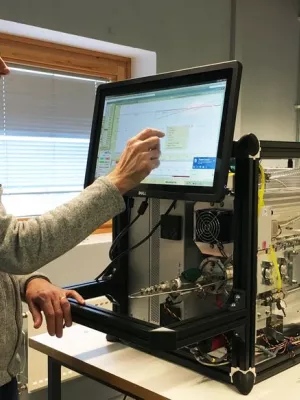
Erik Swietlicki
Professor

Comparison of PM2.5 chemical composition and sources at a rural background site in Central Europe between 1993/1994/1995 and 2009/2010 : Effect of legislative regulations and economic transformation on the air quality
Författare
Summary, in English
From December 1993 to January 1995 and from October 2009 to October 2010, a total of 320 and 365 daily samples of the PM2.5 were collected at a rural background site (National Atmospheric Observatory Košetice) in Central Europe. The PM2.5 samples were analyzed for 29 and 26 elements respectively by Particle-Induced X-ray Emission (PIXE) and water-soluble inorganic ions by Ion Chromatography (IC) in 2009/2010. The Positive Matrix Factorization (PMF) was applied to the chemical composition of PM2.5 to determine its sources. The decreasing trends of almost all elements concentrations, especially the metals regulated by the EU Directive (2004/107/EC) are evident. The annual median ratios indicate a decrease in concentrations of the PM2.5 elements. The slight increase of K concentrations and Spearman's rank correlation coefficient rs 0.09 K/Se points to a rise in residential wood combustion. The S concentrations are nearly comparable (higher mean in 2009/2010, while the annual median ratio is under 1). The five major source types in the mid-1990s were ascribed to brown coal combustion, oil combustion, sea salt and dust – long-range transport, re-suspended dust and black coal combustion. The industrial combustion of brown and/or black coal (rs 0.75 Se/As, rs 0.57 Ga/Ge and rs 0.20 As/Zn) and oil (rs 0.72 V/Ni) of the regional origin dominated. In the 1990s, the potential source regions were the border area of Czech Republic, German and Poland (brown coal), the Moravia-Silesia region at the Czech-Polish border (black coal), and Slovakia, Austria, Hungary, and the Balkans (oil). In 2009/2010, the apportioned sources were sulfate, residential heating, nitrate, industry, re-suspended dust, and sea salt and dust – long-range transport. The secondary sulfate from coal combustion and residential biomass burning (rs 0.96, K/K+) of local origin dominated. The declining trend of the elemental concentrations and change in the source pattern of the regional background PM2.5 in Central Europe between the mid-1990s and 2009/10 reflects the economic transformation and impact of stricter legislation in Central Europe. Study presents positive impact of economic transformation in Central Europe and legislative regulations, especially the air quality EU Directives, on regional background PM2.5 concentrations.
Avdelning/ar
- Kärnfysik
- MERGE: ModElling the Regional and Global Earth System
Publiceringsår
2018-10-01
Språk
Engelska
Sidor
841-851
Publikation/Tidskrift/Serie
Environmental Pollution
Volym
241
Dokumenttyp
Artikel i tidskrift
Förlag
Elsevier
Ämne
- Meteorology and Atmospheric Sciences
- Environmental Sciences
Nyckelord
- Atmospheric aerosol
- Concentrations trends
- Ions
- Long-range transport
- Positive matrix factorization
- Source apportionment
- Trace elements
Status
Published
ISBN/ISSN/Övrigt
- ISSN: 0269-7491